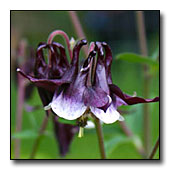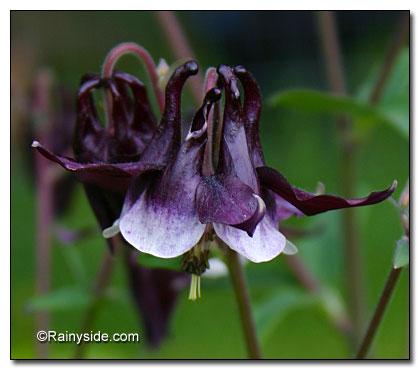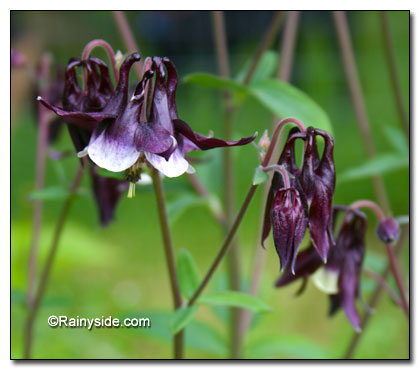Aquilegia vulgaris ‘William Guiness’
COLUMBINE, GRANNY'S BONNET
syn. Aquilegia 'Magpie'
Family: Ranunculaceae
Pronounced: ack-wi-LEE-gee-uh vul-GAR-iss

Quick Jumps
Growing Guide
Rainy Side Notes
GROWING GUIDE

Origin:
Garden.
Plant group:
Perennials.
Hardiness:
Sunset zones: A2, A3; 1-10, 14-24.
USDA zones: 3-8.
Heat zones: 8-1.
Mature size:
Height: 24 inches (60 cm).
Width: 15 inches (37 cm).
Flowering period:
Late spring to early summer.
Flowering attributes:
The flowers have dark purple, deep incurved spurs and white corollas with purple throats, that nod downward with spurs facing up.
Leaf attributes:
Mid-green, two ternate leaves with lobed leaflets.
Light:
Full sun to partial shade.
Soil:
Fertile, moist, well-drained soil.
Feeding:
Add a complete organic fertilizer when planting and again in spring when new growth begins; side dress with compost.
Propagation methods:
Divide in spring; however, they will be slow in recovering.
Pruning Methods:
Dead head spent flowers to prolong bloom. When the flush of flowers are over, cut the plants down to the ground to rejuvenate them. The columbine's new growth is fresh and green the rest of the season.
Pests and Diseases:
Powdery mildew and rust may be problems during dry summers. Caterpillars, aphids and leaf miners can also be problems. In spring, leaf miners tunnel through the surface of the leaves, leaving unsightly foliage. To remedy this, cut the whole plant down to the ground after they finish flowering. The leaf miner larvae are gone by the time the second new growth begins.
Rainy Side Notes

This columbine has an attractive deep purple flower; it is so dark it appears to be nearly black! The short spurs, typical of the vulgaris species, are incurved and because of the nodding flowers, the spurs remain above them. Along with the color, this is what I like most about the blossoms.
Who's Your Daddy?
In his book Columbines, Robert Nold noted that A. 'William Guiness', although listed under vulgaris, might not be a hybrid of one species, but a cross between A. vulgaris and A. atrata. It’s not surprising, since columbines are a promiscuous genus. Unless you grow only one species of Aquilegia, its progeny most likely will be a cross of whatever is growing in your own, or your neighbors’, gardens.
Photographed in author's garden.
Additional Reading
COLUMBINES Aquilegia, Paraquilegia and Semiaquilegia by Robert Nold.
Christopher Lloyd's Garden Flowers: Perennials, Bulbs, Grasses, Ferns by Christopher Lloyd.

Gardening for the Homebrewer: Grow and Process Plants for Making Beer, Wine, Gruit, Cider, Perry, and More
By co-authors Debbie Teashon (Rainy Side Gardeners) and Wendy Tweton
Copyright Notice | Home | Search | Perennials

